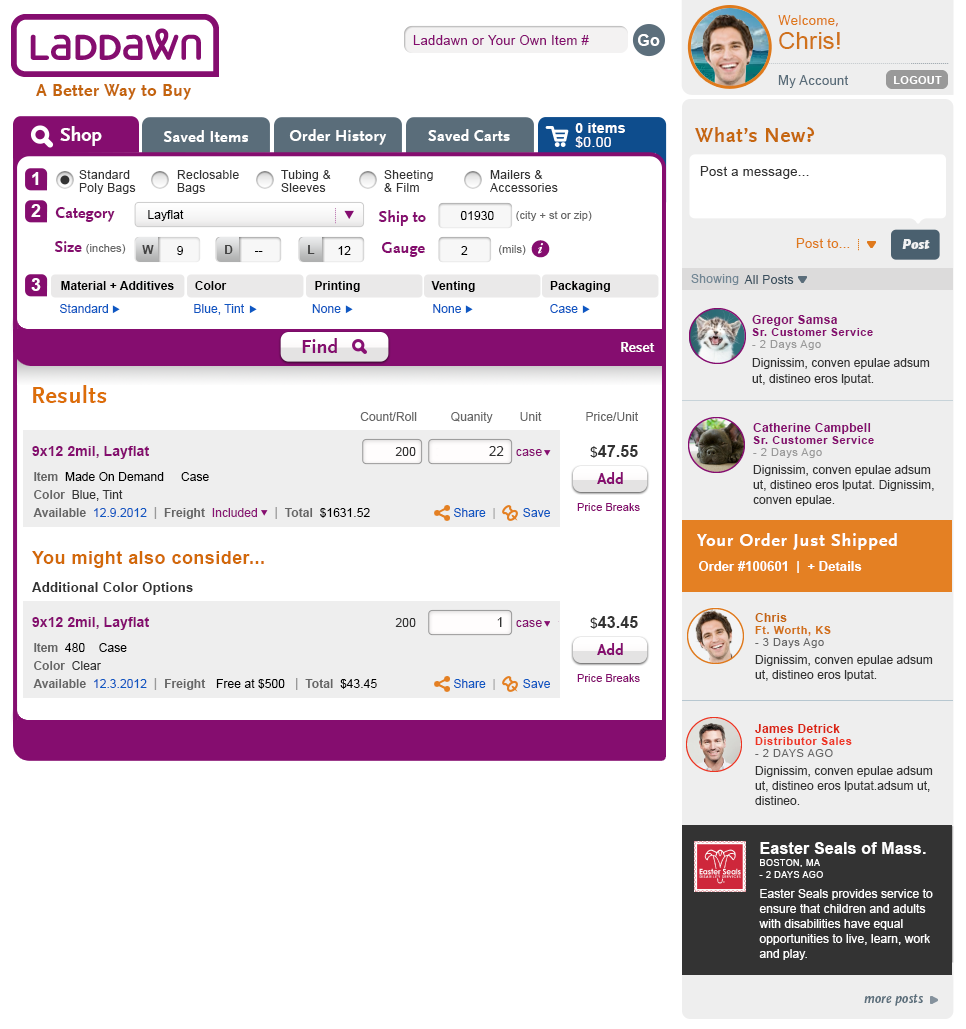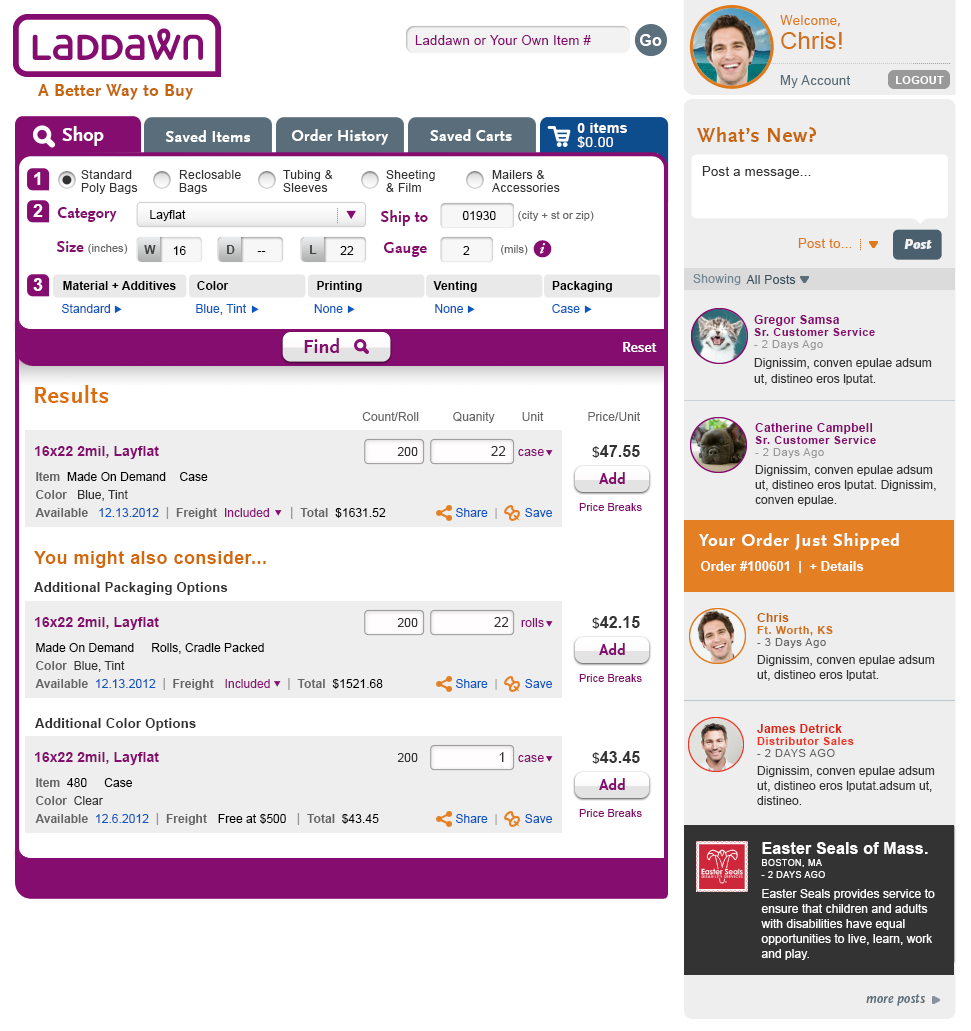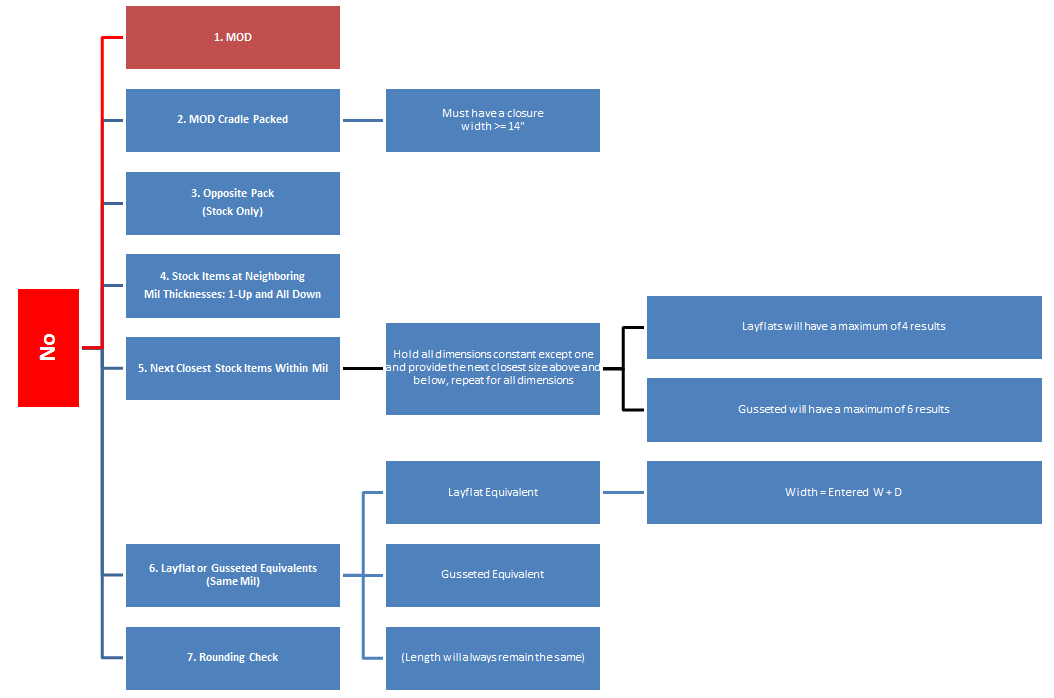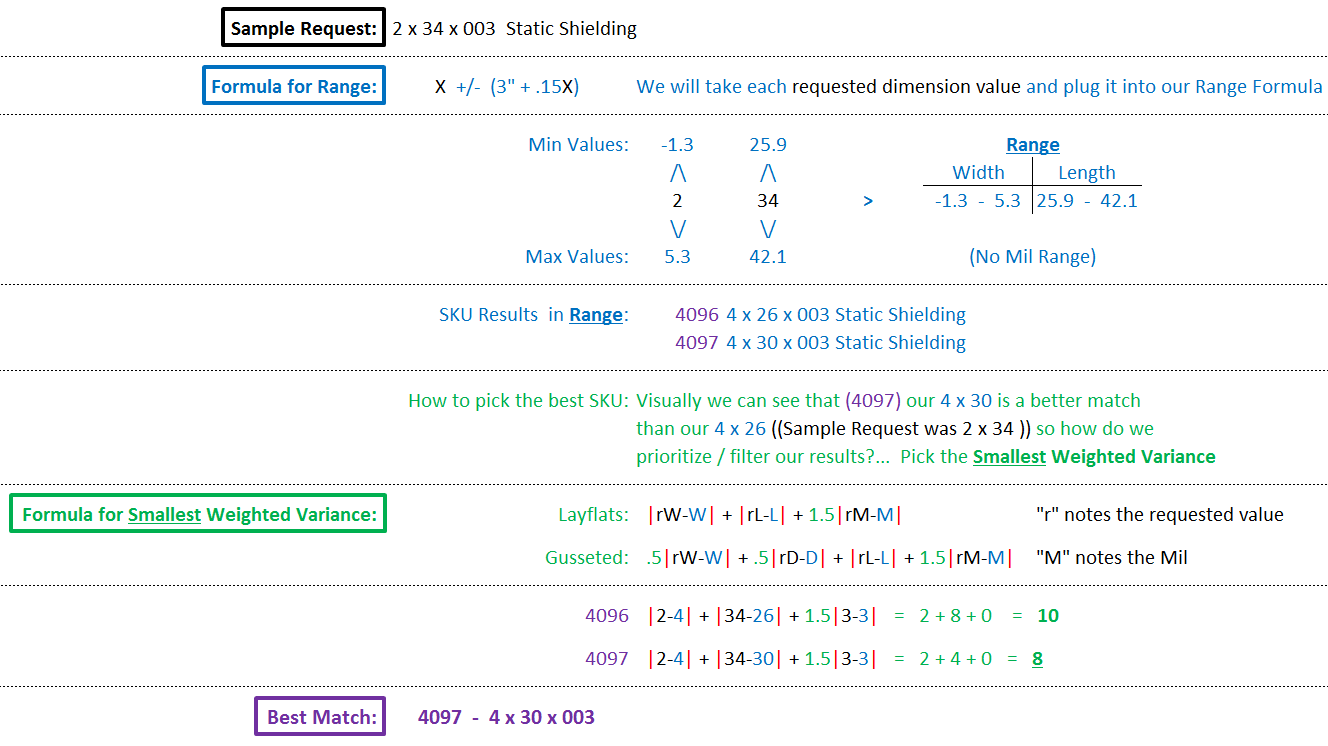YMAC for Bags - No Stock Match: Design
| Scenario A user searches for 9x12 Layflat bags with Blue Tint. | Scenario B user searches for 16x22 Layflat bags with Blue Tint. |
|---|---|
Results logic
Introduction
The following is a mapped out series of YMAC (You Might Also Consider) quote results to be used for selections from either Level 1 "Standard Poly Bags" or "Reclosable Bags." After the user has finished entering their bag specifications in Level 2 & 3 this YMAC process will be used in circumstances where we are unable to generate a stock match. Our objective will be to first show our user a MOD (Made on Demand) quote of the exact request, then highlight credible stock alternatives that minimally deviate from the user's specifications.
Condition – No Match
The user has entered all of their item parameters and our search was unable to produce a stock match.
The Results
The following is a basic outline of how and what we will present to the customer as credible results. The first result will return an exact match to the customer request, while segments 2-6 should be considered to be the YMAC data results.
- MOD
- MOD Cradle Packed
- Opposite Pack (Stock Only)
- Stock Items at Neighboring Mil Thicknesses: 1-Up and All Down
- Next Closest Stock Items Within Mil
- Layflat or Gusseted Equivalents (Same Mil)
- Rounding Check
The Flow Chart
For "YMAC for Bags - No Stock Match" below you will find our flowchart, which maps out our process to use when a user enters a set of dimensions that we are unable to produce a stock match for. Here we can see that users will first find an exact match to their inquiry, followed by credible YMAC substitutions that can be used if their needs are urgent.
The Details
The following is a detailed review of each search result.
1. MOD
In instances where we are unable to match a stock item to a customer's request we will first proceed to quote this job MOD, if we are able (since we can't make every stock item, like Static Shielding bags, but we still allow customers to enter custom dimensions). This is considered to be exactly what the customer was looking for, without alteration.
We now begin the YMAC data.
2. MOD Cradle Packed
The first YMAC result is geared towards "down selling," providing the most inexpensive alternative with minimal change to a customer's request. This will be the only other time we will show the user a MOD alternative. It should be noted that not all items can be cradle packed. For example products that we can't custom make or those cannot be sold on a roll, such as our reclosable bag section, cannot be cradle packed. Also, if an inquiry does not have a width that is greater or equal to 14" then this item cannot be cradle packed (This holds true even if a gusseted item has a combined width and depth of 14" or greater).
3. Opposite Pack (Stock Only)
This query exists to highlight various packaging methods available (Level 3: Cases vs. Rolls Boxed), which will result in a different configuration option for the user to consider. This search is not altering any aspect of the product itself but rather looking for other packing alternatives. Here we are looking at stock products only, regardless of whether or not we can MOD the opposite configuration.
4. Stock Items at Neighboring Mil Thicknesses: 1-Up and All Down
Here we are looking for a stock match under the entered dimensions, but outside of the entered Mil thickness. Here, we will take the Mil that was entered and look above, to the next stock Mil thickness up, and below, to all sequential Mil thickness, in an effort to find this size under a standard Mil thickness.
Example: Say a customer has entered a 20x18x36x004 LD bag, which we don't have under our stock program. Here would show three stock items: 1764 – 20x18x36x003, 1638 – 20x18x36x002, and 1508 – 20x18x36x0015,
5. Next Closest Stock Items Within Mil
Here, we are searching for stock substitution(s) with minimal change to the user's request (staying within one of the dimensions, entered Mil thickness, and layflat or gusseted format). Here, we hold all dimensions constant except one (width, depth or length) and provide the next closest size above and below, repeating this process for all dimensions. Thus, layflat requests will have a maximum of four results; while gusseted will have a maximum of six.
Example: Say a customer entered a 6x7x002 ZT bag. First, holding the width and looking for the next closest length, we would populate 3610A – 6x8x002 ZT and 3605A – 6x6x002 ZT. Next, we will hold the length constant and look for the next widths. This would show item 3580A – 5x7x002 ZT only, since there isn't a ZT bag that is 7" long with a width greater than 6" (we have three results for this example: 3610A, 3605A and 3580A). Please note, we are not looking outside of the specified Mil thickness here.
6. Layflat or Gusseted Equivalents (Same Mil)
Here we will look to alter the width and/or depth dimensions, entered by the user, to provide layflat or gusseted stock equivalents of their inquiry. This means that we are taking the dimensions of a entered layflat bag and altering them in hopes of finding a stock gusseted equivalent, or vice versa. However, for a bag to even be applicable a layflat bag's width must be greater than or equal to 6" and may not be a reclosable bag. If the customer entered a gusseted bag we would add the width and depth dimensions together to create a layflat equivalent and search for a stock match at this dimension. If the customer enters a layflat bag we would take the entered width and repeatedly break it between every possible width & depth combination in effort to find a matching stock SKU in this category's stock program.
Layflat -> Gusseted = Possibility for multiple results
Gusseted -> Layflat = Only one possible result
Example: If a customer were to enter a 4x3x8x002 LD Open here we would be looking for a stock SKU at 7x8x002 LD Open, which returns as item 456.
7. Rounding Check
The last check is a step by step process how we can systematically round to the "closest" stock alternative. We will first calculate an acceptable range that each dimension may deviate from. We will then populate a list of all the SKUs that have met this range criteria, and we will finally filter our results to show "one" result that has the smallest variance from what the user had initially requested.
Notes on Area 7:
- Formula for Range: X +/- (3" + .15X)
- The 3" enables our search to find an acceptable range for smaller bags (if we were to go just off the ".15X" our single digit dimensions would not look beyond the dimension entered)
- The .15X (15%) enables our search to find an acceptable range for larger bags (if we were to go just off the 3" larger dimensions would not look far enough beyond the dimension entered)
- We can always change either of the two values
- Formula for Smallest Weighted Variance: Layflats |rW-W| + |rL-L| + 1.5|rM-M| & Gusseted .5|rW-W| + .5|rD-D| + |rL-L| + 1.5|rM-M|
- The weights, in green within these formulas, assign specific value to each deviation. This will allow us to assign value between each dimensional and Mil difference; presenting our user with one, single result (two if there was a tie)
- We can always change these weights
- |...| designates absolute value, M means Mil, & "r" notes the requested value... so |rW-W| means take the absolute value of our requested width minus the potential SKU's width
- The weights, in green within these formulas, assign specific value to each deviation. This will allow us to assign value between each dimensional and Mil difference; presenting our user with one, single result (two if there was a tie)
- Area 7 will likely reproduce results from Area 4 (Stock Items at Neighboring Mil Thicknesses: 1-Up and All Down) & Area 5 (Next Closest Stock Items Within Mil) and we must ensure that we do not to list a SKU twice in our YMACs
- This is because Area 7 is factoring in the Mil thickness and sizes available within a category, factors that are individually broken down by the two earlier Areas.
- Now we could, easily enough, just remove Areas 4 & 5 but we will lose a means to cleanly label those results (The subject labels Steve has put above our individual YMACs to quickly communicate to the user what is different about this item from what they had originally requested).
- In my (Cliff's) opinion, I would suggest that we run Area 7 for each customer request, but if our result duplicates an item listing from Areas 4 or 5 then we should hide Area 7's result (and not continue searching for a SKU that hasn't already been shown in our YMAC results)
Sample Entries
Examples will be populated once Area 7 has been discussed.



